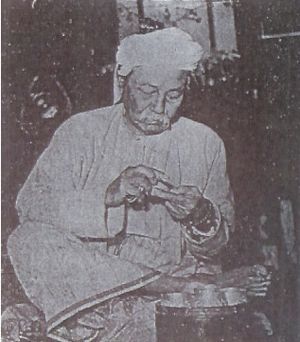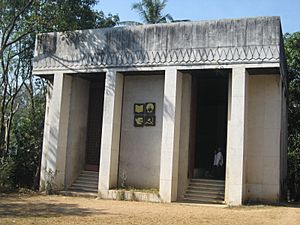Thakin Kodaw Hmaing facts for kids
Quick facts for kids
Thakin Kodaw Hmaing
|
|
|---|---|
 |
|
| Born | Maung Lun Maung 23 March 1876 Walei Village, near Shwedaung, Pyay District, Kingdom of Myanmar |
| Died | 23 July 1964 (aged 88) Yangon, Myanmar |
| Resting place | Kandawmin Garden Mausolea, Yangon, Burma (Myanmar) |
| Pen name | Pandi Lay, Maung Sammadi, Saya Lun, Bow Bow Aung, Mr. Maung Hmaing, Thakin Kodaw Hmaing |
| Occupation | dramatist, poet, journalist, politician |
| Period | 1898–1964 |
| Genre | Nationalist |
| Notable works | Mr. Maung Hmaing Hmadawbon Wuttu 1916 |
| Notable awards | Stalin Peace Prize (1954), Honorary Doctorate, University of Hamburg (1960) |
| Spouse | Ma Shin (1903–1913) |
Thakin Kodaw Hmaing (Burmese: သခင်ကိုယ်တော်မှိုင်း born March 23, 1876 – died July 23, 1964) was a very important person in Myanmar (formerly Burma). He was a great poet, writer, and political leader in the 1900s. Many people call him the 'Father' of Myanmar's fight for independence and its peace efforts. His ideas still influence Myanmar's literature and politics today.
Contents
Early Life and Education
Thakin Kodaw Hmaing was born as Maung Lun Maung in a village called Wale, near Shwedaung in Lower Burma. When he was young, he went to Mandalay to study in the traditional way. At age nine, he saw the British take over Myanmar. He watched King Thibaw and Queen Supayalat being taken away. This moment deeply affected him. It made him want to fight for his country's freedom for the rest of his life.
A Gifted Writer and Poet
In 1894, Hmaing moved to Yangon (then called Rangoon) to become a playwright. He later became a journalist, writing for a newspaper in Mawlamyaing. In 1903, he married Ma Shin. He returned to Yangon in 1911 as the movement for independence grew stronger. He worked for the Thuriya (Sun) newspaper. He was already well-known for his plays, which were based on old Burmese stories and myths.
Hmaing was amazing at writing classical Burmese literature. He could write poetry so easily and beautifully that few others could match him. He was a master of complex rhymes. One of his famous lines is: Kaung myo ahtweidwei yenè chunzei myazei saw, daung owei yelo tunzei kazei thaw (ကောင်းမျိုးအထွေထွေ ရယ်နဲ့ ချွန်စေမြစေစော ဒေါင်းအိုးဝေရယ်လို့ တွန်စေကစေသော). This means: "May many good things grow strong; may the peacock sing and dance." The dancing peacock was a symbol of Myanmar's freedom.
Hmaing also wrote clever satires (stories that make fun of things) mixed with poetry and prose. These were like religious commentaries called htikas (ဋီကာ). For example, in Hkway htika (On Dogs), he criticized politicians. He felt they were wasting time arguing instead of working to end colonial rule.
Here are some of his famous htikas:
- Kja htika - On Lotus (1912)
- Bo htika - On Chiefs (1914)
- Daung htika - On Peacocks (1920)
- Myauk htika - On Monkeys (1923)
- Hkway htika - On Dogs (1925)
- Boingkauk htika - On Boycott (1927)
- Galonbyan dipani htika - On the Flying Garuda (1931)
- Thakin htika - On Thakins (1938)
The Story of Mr. Maung Hmaing
In 1916, Hmaing wrote a novel called Missata Maung Hmaing hmadawbon wuttu. He used the pen name Mr Maung Hmaing. This book caused a stir on purpose! "Maung Hmaing" was a character in a popular novel at the time. By calling himself "Mister Maung Hmaing," he was making fun of some Burmese people who started using "Mr" in front of their names to sound more British. This book helped stop that trend, and the name "Mr. Maung Hmaing" stuck with him.
A Leader for His Nation
In 1934, Hmaing joined a nationalist group called the Dobama Asiayone (We Burmans Association). He quickly became a leader of the young Thakins. This title, "Thakin," meant "master" or "owner." It showed that they believed they were the true masters of their own land, not the British. Because of this, he became known as Thakin Kodaw Hmaing (Master Lord Hmaing). Later, people called him Sayagyi (great teacher) Thakin Kodaw Hmaing.
Hmaing was also amazing at another type of poetry called Laygyo gyi (လေးချိုးကြီး). He used this old style to write about current political issues. He inspired many Burmese people to fight for independence. He made them proud of their history, language, and culture. He also encouraged them to take action, like student and worker strikes. His book Boingkauk htika (On Boycott) was about this. He was also tough on politicians who were only looking out for themselves, as seen in Hkway htika (On Dogs). His clever and memorable poems made him very popular. This style also helped his work avoid being censored by the British government.
In 1936, after the second university student strike, the All Burma Students Union (ABSU) was formed. Hmaing was chosen as its patron. By 1941, the British government saw him as an "enemy of the state" because of his strong nationalist views. Hmaing and other Dobama leaders sent Aung San and other young men, known as the 'Thirty Comrades', to get military training abroad. Their goal was to fight the British.
Working for Peace
After Myanmar gained independence in 1948, the country faced a civil war. This made Hmaing very sad. He spent the rest of his life trying to bring peace to the country. He became a key figure in the world peace movement in Myanmar. In 1952, he went to a Peace Conference in Beijing. That same year, he became Chairman of the World Peace Congress (Burma). He won the Stalin Peace Prize in 1954. Hmaing traveled to People's Republic of China, Mongolia, Hungary, and the Soviet Union in 1953. He also went to Ceylon and India for the World Peace Conference in 1957. In 1960, the University of Hamburg in Germany gave him an honorary doctorate degree.
Thakin Kodaw Hmaing strongly supported the Internal Peace Committee in 1963. This committee tried to make peace between the government and different rebel groups. Hmaing was a voice that everyone respected, no matter their political side. After the military took power in 1962, he was the only political voice they could not silence. He passed away in 1964 at the age of 88. After his death, all political parties except the ruling one were banned.
Towards the end of his life, he focused more on peace and less on writing. His last wish was to see a peaceful and united Myanmar. He was buried at Kandawmin Garden Mausolea near the Shwedagon Pagoda. On March 23, 1976, which was 100 years after his birth, over 100 students were arrested for holding a peaceful ceremony at his tomb.
Anna Allott, a writer, described Thakin Kodaw Hmaing as "a man of many skills." She said he was a true Buddhist, a strong patriot, a poet, a playwright, a historian, a teacher, and a pioneer writer. He is the most respected literary figure in modern Myanmar.
See also
 In Spanish: Thakin Kodaw Hmaing para niños
In Spanish: Thakin Kodaw Hmaing para niños


